Muay Thai, also known as the “Art of Eight Limbs,” is well-known for its powerful strikes, particularly its devastating kicks. Muay Thai fighters undergo rigorous training to develop strength, speed, and technique, contributing to the force behind their kicks. Let’s explore the science and figures behind the hard-hitting kicks of Muay Thai fighters and discuss the factors that contribute to their remarkable power.
The force of a Muay Thai kick can range from 1,000 to 2,700 pounds of force (approximately 4.5 to 12 kN), depending on the individual fighter and their skill level. This force is generated through a combination of factors, including the rotation of the hips, the use of the entire kinetic chain, and the technique and experience of the fighter.
Nak Muay is well known to have the most powerful kicks in combat sports. But why is that? And how do they practice such power?
The Science and Figures Behind the Kicks
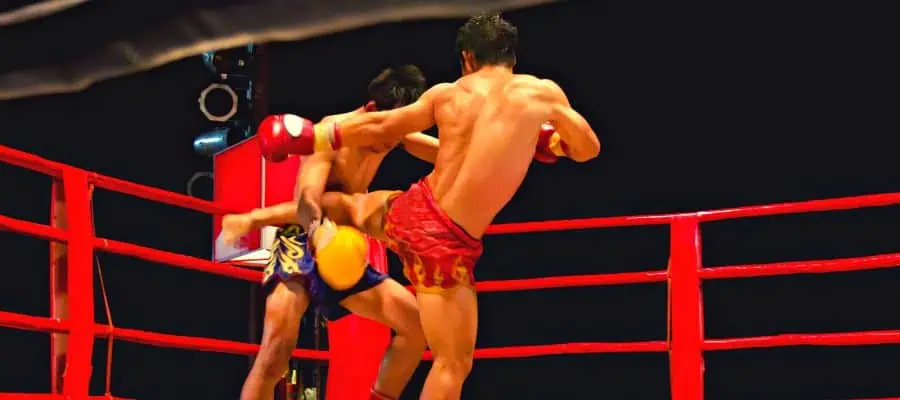
In the realm of Muay Thai, the goal of a kick is not just to hit your opponent but to feel like you’re kicking right through them. This way of thinking is often described as “breaking the opponent.” It’s a common tactic Muay Thai fighters use to pack a punch (or a kick!) with maximum force and impact
But how do they do it? It’s all about using your whole body, from your hips all the way down to your shins, to put as much power and momentum behind the kick as possible. This isn’t just a flick of the leg; it’s a full-body power strike, engaging multiple muscle groups in a coordinated effort.
“Breaking the opponent” aims to kick to penetrate the target rather than just tapping it and pulling back. In other words, you’re putting your all into it, throwing your kick with full force and speed. And you don’t stop there – to keep balance, you often follow through with the motion, either by stepping forward or pivoting.
The force behind a Muay Thai kick can vary quite a bit. According to a study by Dr. Michael H. Graham at the University of Bridgeport, it can range from 1,000 to 2,700 pounds of force, depending on the fighter’s skill level. To put that in perspective, a professional boxer’s punch can pack a force of around 700 to 1,200 pounds. So, you can see, Muay Thai kicks can carry quite a wallop!
So, what makes a Muay Thai kick so powerful? There are several elements at play. Firstly, hip rotation is key. It creates torque, a twisting force that drives the leg forward. Combine this with the weight and speed of the leg, and you’ve got a powerful impact when the foot makes contact.
Additionally, Muay Thai fighters use their whole body — core, legs, hips — to efficiently transfer energy into their kicks. This coordinated effort lets them generate impressive power and speed in their strikes.
What Makes a Muay Thai Kick so Powerful?

It’s a combination of factors that come together to create a forceful strike. Hip rotation is one of the main contributors to kick force. When a Muay Thai fighter kicks, they generate torque by spinning their hips, which pushes the leg forward with more speed and power. They also use their whole body — core, legs, hips — to transfer energy efficiently from their body into the kick.
Leg and core muscles also play a big part. Fighters focus on strengthening their quadriceps, glutes, and hip flexors to up the power and speed of their kicks. Strong legs let them execute high kicks with ease. At the same time, a robust core allows them to generate force from their upper body and efficiently transfer it to their lower body.
The angle of impact is also key. Fighters aim to hit their opponents with their shin or instep, the toughest parts of the leg. The shin, in particular, is great for delivering knockout kicks thanks to its solid bone structure and thickness. To pack a maximum punch, fighters must position their leg right and execute the kick precisely.
How Do You Train for Powerful Muay Thai Kicks?
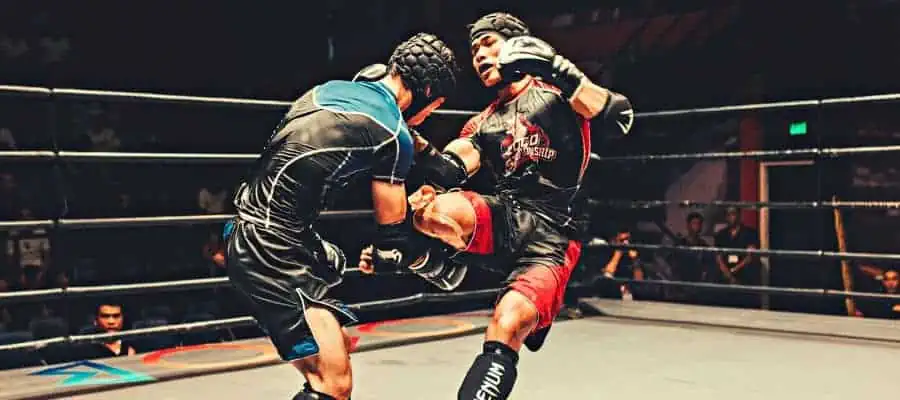
Muay Thai fighters undergo intense training and conditioning to build the strength and technique needed for powerful kicks. This usually involves a mix of strength and conditioning exercises, pad work, heavy bag training, and sparring.
Strength-building exercises like squats, lunges, and deadlifts help develop leg and core strength. These exercises help build muscular power and stamina, allowing fighters to execute explosive kicks repeatedly without tiring. Flexibility is also crucial for high, fast, and accurate kicks, so fighters work on stretching and mobility exercises to boost their range of motion.
Specific training techniques can also be used to focus on enhancing the power of Muay Thai kicks. Box jumps, for example, are great for developing explosive leg power and extending the hips. They involve jumping up onto a box or platform, stepping back down, and repeating the process.
Kick training with an elastic band can be another effective technique. The band is attached to a stationary object, and the fighter kicks against the resistance. This method is beneficial for building leg and core strength while also improving balance and coordination.
Incorporating sprints into training routines can improve overall speed and explosiveness. They involve running at maximum speed for short distances, followed by a period of rest. This type of training is excellent for developing fast-twitch muscle fibers, which are essential for quick, powerful kicks.
Hip flexor exercises, like hip thrusts and leg raises, can also help improve kick power. These exercises target the hip flexor muscles, which are key for generating the rotation needed for a powerful kick.
But it’s not all about strength – technique plays a crucial role too. Fighters spend countless hours practicing their kicks on pads and heavy bags, focusing on hip rotation, foot placement, and striking correctly to maximize power and minimize injury risk. Timing and accuracy are also critical, so fighters practice combinations, counterattacks, and sparring to get a feel for distance and timing.
What Is the Role of Skill and Experience in Muay Thai Kicks?
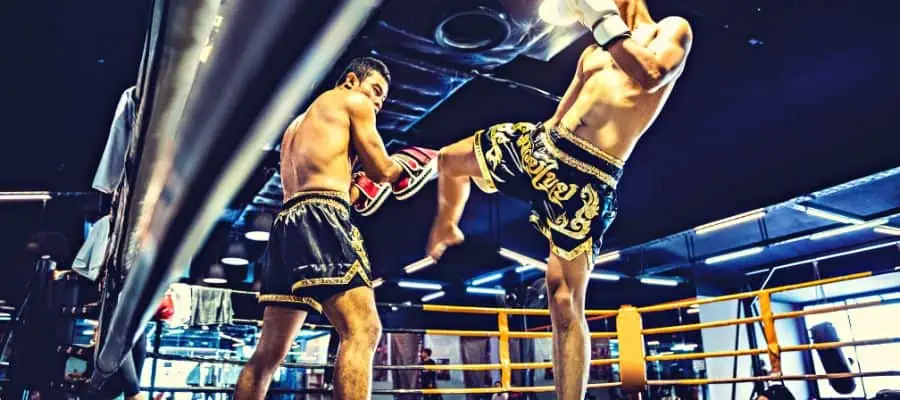
While strength and conditioning are essential for developing powerful Muay Thai kicks, skill and experience are just as important. Skilled and experienced fighters can generate more force with their kicks due to their refined technique and efficient use of the kinetic chain.
Plus, they’re better at anticipating their opponent’s movements and landing kicks with precision and accuracy, which makes their strikes even more effective. Experienced fighters also understand when and how to use their kicks in different situations.
They can read their opponent’s movements and determine which kicks will likely be most effective. With experience comes confidence, allowing fighters to execute their kicks with greater speed, power, and accuracy. So, in a nutshell, the power of a Muay Thai kick comes from a mix of strength, technique, and experience. Training and conditioning help develop the physical attributes needed.
At the same time, technique and experience are crucial for executing kicks with maximum force and effectiveness. With the right combination of training, skill, and experience, Muay Thai fighters can deliver devastating kicks that can end a fight in a heartbeat.
Are Muay Thai Kicks the Strongest?
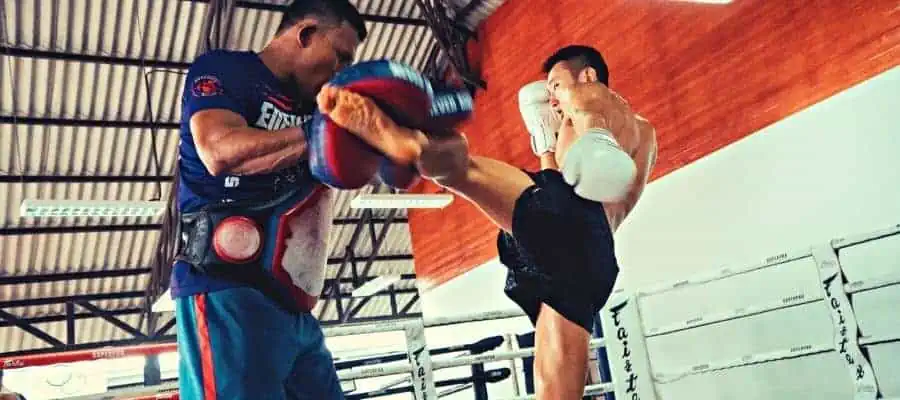
Muay Thai kicks are often compared to being hit with a baseball bat. The leg is used as a baseball bat, generating significant power and force, unlike the whip-like motion used in other martial arts. A Muay Thai kick is executed with the full force of the leg, from the hip down to the shin, for maximum impact.
In contrast, martial arts like karate and taekwondo use a whip-like motion where the leg is snapped out and quickly pulled back. While still powerful, these kicks may not produce the same level of force as a Muay Thai kick.
In boxing, punches are primarily powered by the arms and shoulders, with less emphasis on the legs and hips. So, while a boxer’s punch can still pack a punch, it might not match the raw power of a Muay Thai kick.
The power of a Muay Thai kick comes from several factors working together. This includes using the entire kinetic chain, the hips’ rotation, and the leg’s positioning. Muay Thai fighters undergo intense training to develop the strength and technique needed to deliver powerful kicks precisely and accurately.
Which Muay Thai Kick is the Strongest?
Each type of kick: low, middle, and high – can pack a serious punch, depending on the skill and technique of the fighter.
In Muay Thai, the middle kick often gets the spotlight. It’s versatile, able to target various areas on an opponent’s body, from the legs to the torso and even the head. But that doesn’t mean low and high kicks are any less potent. In fact, many Muay Thai fighters will alternate between low and middle kicks to keep their opponents guessing and off balance.
The low kick, targeting the opponent’s legs, can be a game-changer. A powerful low kick to the opponent’s thigh or calf can deal significant damage and limit their ability to move or counterattack. Similarly, the high kick, aimed at the head or neck, can deliver a knockout blow or cause serious injury.
While we don’t have the exact numbers, we would bet that the low kick should pack the most power, closely followed by the middle kick.
Conclusion
Muay Thai kicks are renowned for their power, thanks to the technique and conditioning that goes into mastering them. Fighters use their whole body to generate torque and momentum, delivering strikes with serious punch. They spend hours training, with strength and conditioning exercises, pad work, heavy bag training, and sparring all playing a key role. They also use specific exercises like box jumps, elastic band kicks, sprints, and hip flexor exercises to boost their kick power. While the middle kick is often seen as the most effective, low kicks are most likely the most powerful when executed with skill and precision.
If you found this article useful, you may want to save this pin below to your Combat Sports board.
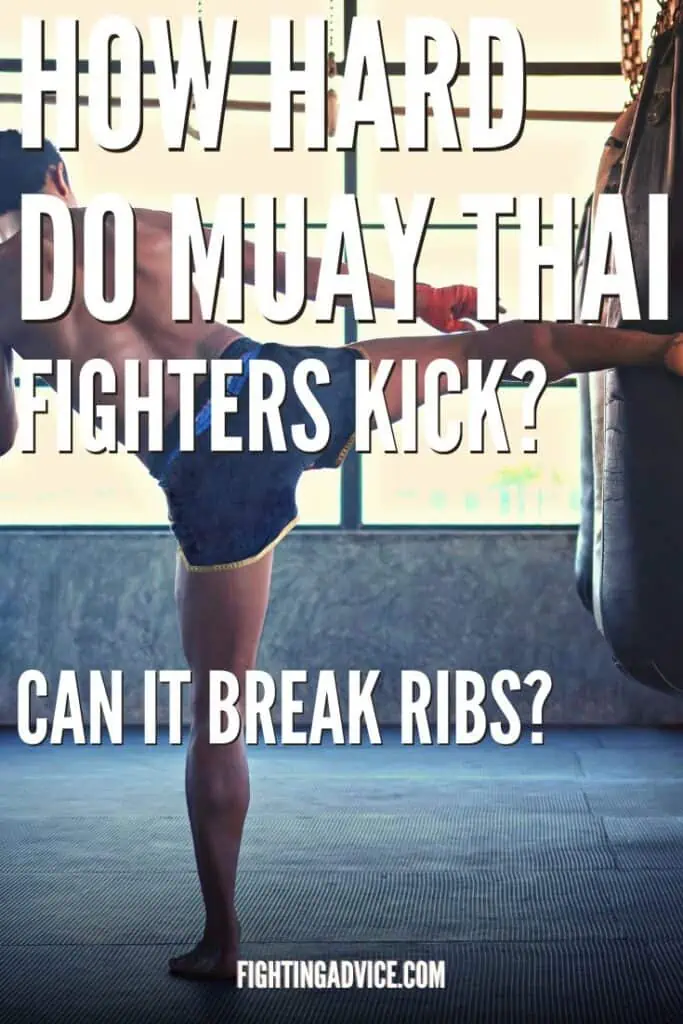
Recent Posts
Muay Thai's global appeal draws enthusiasts to Thailand, where the tropical climate and friendly locals create an ideal backdrop for self-defense training. Regardless of experience, Muay Thai in...
Exploring the realm of Muay Thai, a captivating, striking art and sport rooted in Thailand. Its global popularity has reached the United States, where American Muay Thai fighters have left an...
